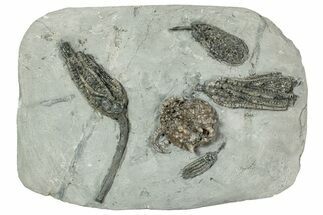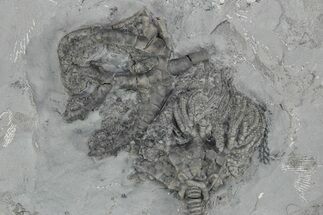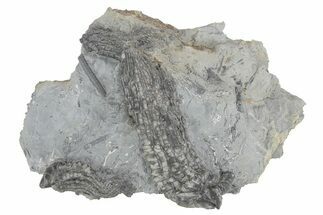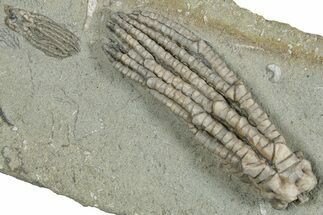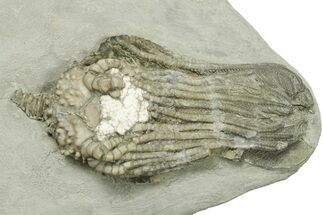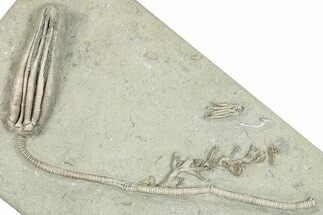This Specimen has been sold.
8.3" Fossil Crinoid Plate (Ten Species) - Crawfordsville, Indiana
This is a beautiful, 8.3" plate of detailed fossil crinoids from Crawfordsville, Indiana. There are thirteen crinoids representing ten separate species. They have been microscopically prepared using air abrasives. A partial gastropod of the species Platyceras equilaterelis can also be found on this plate.
An acrylic display stand is included for your convenience.
The crinoids include:
#16 - Cyathocrinites sp. (x2)
#17 - Cyathocrinites multibrachiatus
#35 - Pachylocrinus aequalis (x2)
#36 - Hylodecrinus gibsoni
#37 - Abrotocrinus manus
#52 - Actinocrinites gibsoni
#54 - Agaricocrinus americanus
#72 - Platycrinites brevinodus
#81 - Onychocrinus ulrichi (x2)
#100 - Cyathocrinites iowensis
An acrylic display stand is included for your convenience.
The crinoids include:
#16 - Cyathocrinites sp. (x2)
#17 - Cyathocrinites multibrachiatus
#35 - Pachylocrinus aequalis (x2)
#36 - Hylodecrinus gibsoni
#37 - Abrotocrinus manus
#52 - Actinocrinites gibsoni
#54 - Agaricocrinus americanus
#72 - Platycrinites brevinodus
#81 - Onychocrinus ulrichi (x2)
#100 - Cyathocrinites iowensis
Crinoids from the Ramp Creek Limestone were likely buried in sediment from nearby deltas during storms. The resulting siltstone deposits are soft enough that fossils can be extracted in exquisite, three-dimensional relief.
Crinoids, sometimes commonly referred to as sea lilies, are animals, not plants. They are echinoderms related to starfish, sea urchins, and brittle stars. Many crinoid traits are like other members of their phylum. Such traits include tube feet, radial symmetry, a water vascular system, and appendages in multiples of five (pentameral). They first appeared in the Ordovician (488 million years ago) and some species are still alive today.
Crinoids, sometimes commonly referred to as sea lilies, are animals, not plants. They are echinoderms related to starfish, sea urchins, and brittle stars. Many crinoid traits are like other members of their phylum. Such traits include tube feet, radial symmetry, a water vascular system, and appendages in multiples of five (pentameral). They first appeared in the Ordovician (488 million years ago) and some species are still alive today.
SPECIES
Multiple Species
LOCATION
Crawfordsville, Indiana
FORMATION
Edwardsville Formation
SIZE
8.3 x 4.4" rock
CATEGORY
SUB CATEGORY
ITEM
#269722
We guarantee the authenticity of all of our specimens.
 Reviews
Reviews

